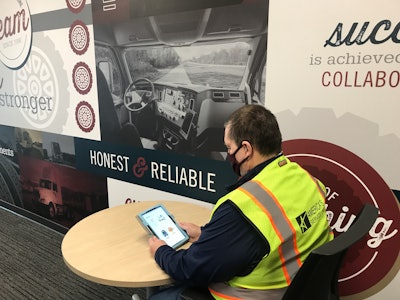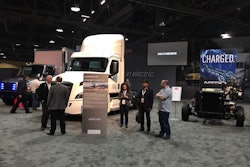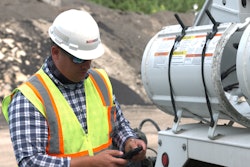
What types of learning interactions do you use at your organization? Most interactions observed in the trucking industry are learner-to-content or learner-to-instructor. Did you know that other types of learning interactions can be designed in an online, face-to-face, or blended (a combination of online and face-to-face) learning environment?
One example is a learner-to-learner approach called communities of learners (COLs). This is not a new concept, but it has been missing in the trucking industry. The idea of COLs is to empower learners to collectively learn together and build on each other’s knowledge, instead of assimilating knowledge based simply on what they are told.
Keith Maisch, the safety manager at America’s Service Line, a fleet of 200 tractors and 350 refrigerated trailers based in Green Bay, Wis, implemented COLs in the spring of 2021.
Maisch noted that, historically, there hasn’t been a good way to get drivers together so they could learn from each other. However, technology makes it possible for drivers to interact, teach, and learn from each other while they’re waiting to get loaded or unloaded, or whenever they have the time.
The Implementation Strategy
Over a two-month period, Maisch implemented COLs as part of an online discussion format where drivers could learn from him and each other on the topics of defensive driving and health and wellness. The drivers went through eNuggets, or short micro-lessons, and then were prompted with divergent questions where drivers could respond to Maisch, respond to each other, or develop an original post.
The drivers did not need to be online at the same time to participate. In fact, they could complete their work and go back later to see how drivers responded and comment on their posts.
The timeline for each of the two discussions was one month. During the first month, the discussion replaced the traditional safety assessments, and during the second month, drivers had a choice to complete the safety assessments or discussion prompts for their monthly safety training. Through a content analysis, the responses were independently coded to examine the engagement of the drivers and the benefits to the industry. The full research report can be downloaded: A Springboard for Engagement and Retention Using a Community of Learners Approach With America’s Service Line.
The Results
When starting the process, Maisch worried that drivers might not post content that was appropriate or relevant to the questions he presented. However, the results were quite the opposite. Overwhelmingly, the drivers posted relevant information about distracted driving (94%, n=171) and health and wellness (100%, n=37).
Maisch was surprised that drivers who he thought would give the most pushback actually shared relevant information and actively engaged with each other. It was clear that drivers wanted to share their outside knowledge and give examples from their own lives and experiences.
Moreover, the COL approach gave all drivers, male and female, opportunities to connect with each other instead of learning in isolation or passively listening to videos. Of the posts in the defensive driving discussion, 81% (n=133) were posts between drivers or posts where drivers shared original ideas, instead of just interacting with Maisch.
Female drivers (100%, n=5) responded to peers in the health and wellness discussion, sharing suggestions for healthy eating. Literature reviews of online learning discussions have shown that females are motivated to engage in learning communities to communicate and build social connections.
More drivers completed the training when there was a choice of how to engage and learn (n=25 vs. n=91). Notifications were not set up to let drivers know that there was training available, but with the COL approach, drivers took the initiative to log in and complete their training.
The Benefits for Trucking
America’s Service Line's research supports the general documented benefits for educating through a COL, but the approach has wider implications for trucking as noted below:
1. Makes learning relevant by bringing in multiple perspectives. COLs show learners that the knowledge they bring to the learning experience is valued. COLs use real-world experiences to make applications relevant to learners’ immediate lives.
2. Bridges the communication and connection barrier to retain drivers. COLs support the learner’s ability to work, learn, and communicate with others, and have the potential to engage learners during and beyond the formal educational learning experience.
At America’s Service Line, Maisch found that over half of the posts involved drivers engaging with other drivers, instead of responding to the instructor or posting their thoughts in isolation. When drivers are actively engaged in the teaching process, they feel like they are an integral part of the company.
3. Helps with retention of knowledge while building a safety culture. Instead of being passive recipients of knowledge, this strategy requires learners to think abstractly and build on existing skills and knowledge structures. Making meaningful connections for learning is necessary for knowledge to enter into long-term memory.
Lessons Learned from America’s Service Line
1. Communicate expectations. The first step in implementing a COL is to communicate expectations. Do the drivers know how to participate? Do they know why they are participating?
2. Trust the driver. It is important to trust drivers to post appropriate and meaningful responses. They do have a lot of great knowledge to share, and they want to share it. The instructor can coach and redirect misinformation and can even moderate posts if desired or deemed necessary.
3. Provide choice. There is not just one way to learn information. In fact, we know that all adult learners appreciate having a choice on how to learn and also the mediums or ways in which they learn. Give drivers a choice on whether they demonstrate knowledge through discussions or through traditional assessment questions.
4. Build confidence. Not everyone feels confident in their typing skills or spelling abilities. Encourage them by reminding them that they are not being graded on their ability to type or spell. Provide examples of acceptable responses or recognize learners for their responses.
5. Give multiple opportunities to engage. Make this strategy part of an ongoing effort to connect learners to content and to each other.
6. Create an atmosphere of acceptance. Set boundaries and expectations for how the group should treat each other, and be the example. The supervisor/instructor should not dominate the discussion; rather, they should highlight positive interactions and point out exemplary behaviors and posts.
Dr. Gina Anderson is the CEO of Luma, an instructional design and learning company. She has studied driver learning behaviors in trucking since 2014 and has published learning strategies for the trucking industry in the book Teaching Without a Teaching Degree: Luma Learning Lessons, which includes 106 different teaching strategies spread out over 52 lessons.












